#937 – Dick Bernard: A Look Back at the History of the State of North Dakota as it approaches its 125th birthday.
Today, September 17, is Constitution Day in the United States. This year the U.S. is 227 years young.
Happy Birthday!
Some serendipity happenings cause me to give focus, this day, to the original Constitution of the State of North Dakota.
North Dakota is my home state.
This year, November 2, is the 125th birthday of North Dakota – the 32nd state of the U.S. (South Dakota is 33rd). Elwyn Robinson, author of the definitive history of North Dakota, gives this description of the beginnings of the ND Constitution Convention in 1889: ND Constit – Robinson001.
Most of the text and illustrations which follow come from the 1911 Blue Book of North Dakota, which I found this summer amongst the belongings at the LaMoure County farm where my mother grew up. Her parents came to that farm from extreme southwest Wisconsin (near Dubuque IA) in March of 1905. Her Dad, my Grandpa Fred Busch, seems always to have been interested in politics, and it is probably thanks to him that I now have this old book. In the books illustrations (below) you see evidence of pencil scrigglings. Most likely, they were made by my then-two year old mother, Esther: she was born in 1909, and by the time this book was at the farm home, she was probably at the age where a pencil and paper had some relationship together. (The final picture, at the end of this post, is of the first page of the book. Likely an Esther Busch original!)
(click to enlarge)
North Dakota’s history, like all places, then to now,is a very complicated one. For anyone interested there are a great many sources and observations interpreting North Dakota’s early history and the torturous course of its Constitution pre and post 1911. Between statehood in 1889 and 1911, when this book was published, there had been great changes in ND, with extremely rapid growth. It was doubtless an exciting time on the prairie; a time of transition. The history as recorded in the book is as known and accepted as fact in 1911.
Here is the 1889 Constitution of North Dakota as reprinted in the 1911 Blue Book: ND Constitution 1889001
Dr. Jerome Tweton much later wrote an interesting commentary on a later effort to redo the oft amended original Constitution.
Here is the summary history of the state and Dakota Territory, its predecessor, as written in the same book: ND TerrHist writ 1911 002 [See note at end of this blog].
Dad’s side of my family preceded ND statehood.
My grandmother Bernard, then Josephine Collette, was born eight years before statehood at St. Andrews, where the Park and Red Rivers come together in Walsh County ND. Her parents came to ND in 1878; several uncles and Aunts came west about the same time.
Her uncle, Samuel Collette, who migrated to the St. Paul MN area from Quebec in 1857, was the first family member to see North Dakota. He was part of the Minnesota Mounted Rangers in 1862-63, a soldier in the so-called Indian War, and likely was with that unit in 1863 when it reached what later became Bismarck. This was a bit before Interstate 94.
Every state has its symbols.
Here are the 1911 descriptors of the Wild Prairie Rose, the State Flower, and the North Dakota Flag: ND Flower Flag 1911 002. These are the only state symbols within the book.
There is no descriptor of the North Dakota Seal in the 1911 book. Here is a more current interpretation of that Seal.
I found most interesting, in the reverential description of the ND flag, the many references to the Spanish-American War in the Philippines 1898-99. My Grandpa Busch, Mom’s Dad, would not, in 1911, have had any idea that his future brother-in-law, my Grandpa Bernard, Dad’s Dad, who came to Grafton from Quebec about 1894, was in that war, spending that entire year in the Philippines, part of Co C, Grafton. Where that ND flag was, there was Grandpa Bernard. I have visited Manila, Pagsanjan and Paete, all mentioned in that description.
Without knowing it, the two ND families were already “tied” together. (Another book found at the Busch farm is one about the Spanish-American War written at the time of the war in the grandiose style of the time.)
North Dakota was one of the earliest enrollees in Theodore Roosevelt’s Spanish-American War, spring of 1898. Of course, the “Roughrider”, Teddy Roosevelt, had spent two important years in ND in the mid 1880s, living in the Badlands not far from todays Medora. In a way, by 1898, Theodore Roosevelt had become a North Dakotan.
(click to enlarge)
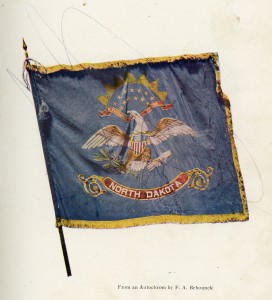
ND Flag, as presented in the 1911 North Dakota Blue Book. Scribbles likely compliments of then 2-year old Esther Busch.
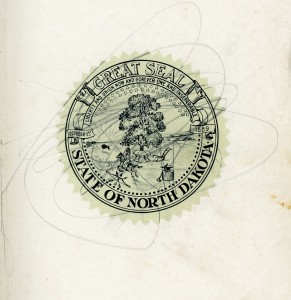
Great Seal of North Dakota in 1911 ND Blue Book. Scribbles likely contributed by then 2-year old Esther Busch of Henrietta Township, rural Berlin ND.
Esther Busch went on to Henrietta Township School #1 near Berlin ND, thence to St. John’s Academy in Jamestown, thence Valley City State Normal School. She became a North Dakota Public School elementary school teacher in the late 1920s, met her future husband Henry Bernard at Valley City State Normal School, and together they taught a total of 71 years in North Dakota Public Schools.
Happy Birthday, North Dakota!
re ND TerrHist link above: At page four of the link you’ll find the population of ND by decades until 1910. Succinctly, the population grew by 75% from 1890 to 1900, thence 80% from 1900 to 1910 to a 1910 population of 577,000.
That more or less remained the population of North Dakota until the recent oil boom.
They say ND is now about 700,000; In the 1960 census, when I was a junior in college, ND population was about 630,000. When I did the Busch family history some years ago I looked up the population of Berlin, which was platted in 1903 and incorporated in 1906. Berlins highest population ever was in 1910, 137 people. It was all downhill from there. The current population of Berlin, ND is about 35. Here’s how it looked about 1910: Berlin ND early pre-1910001
The present ND population boomlet is in the Bakken oil west (Williston, Minot, Bismarck, Dickinson areas) and in the cities, particularly Fargo and Grand Forks.

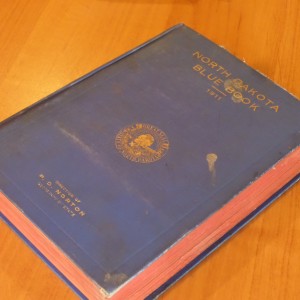
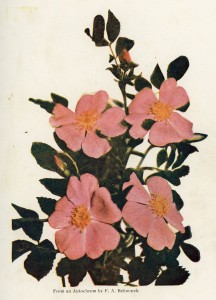
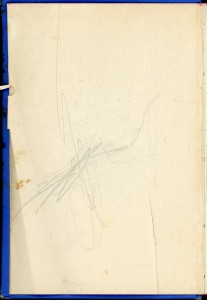
Leave a Reply
Want to join the discussion?Feel free to contribute!